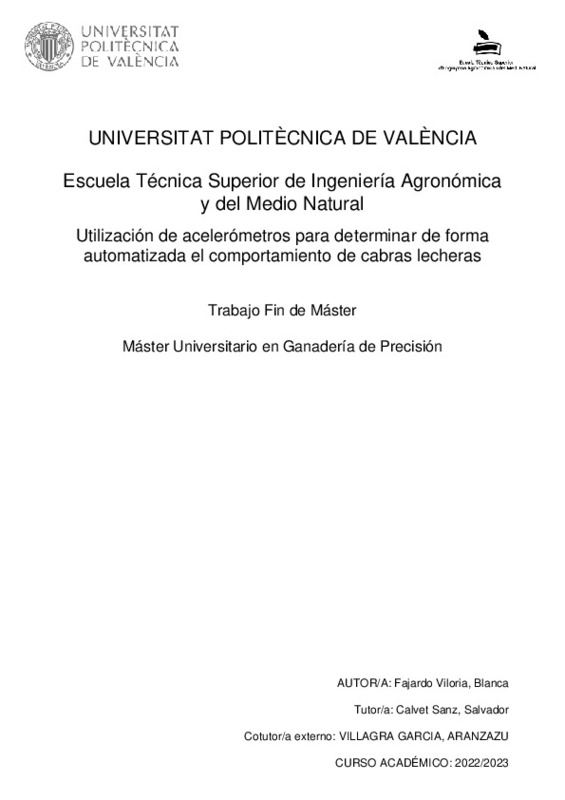|
Resumen:
|
[ES] El monitoreo automático del ganado es una gran herramienta a utilizar cuando se quiere observar el comportamiento animal a nivel individual sin recurrir a la observación directa. Los sensores acelerómetros se utilizan ...[+]
[ES] El monitoreo automático del ganado es una gran herramienta a utilizar cuando se quiere observar el comportamiento animal a nivel individual sin recurrir a la observación directa. Los sensores acelerómetros se utilizan ya de forma efectiva en otras producciones ganaderas para detectar problemas de salud en los animales. Estos dispositivos son capaces de registrar cambios de intensidad de la actividad, lo que nos permite diferenciar comportamientos. Este trabajo pretende monitorizar el nivel de actividad y de descanso utilizando dos tipos de acelerómetros. El trabajo se ha realizado en las instalaciones del Instituto de Ciencia y Tecnología Animal, utilizando cabras en período de secado. Durante el estudio, se registró el comportamiento de las cabras mediante observación directa, comparando posteriormente estos registros con la información proporcionada por los acelerómetros. Usando estos sensores en estos animales, el descanso, estar de pie y caminar se detectaron con precisión desde un sensor colocado en el cuello. Con un mayor desarrollo, el algoritmo de clasificación utilizado para tratar los datos obtenidos mediante el acelerómetro, podría vincularse con un sistema automático de seguimiento del ganado proporcionando información en tiempo real sobre el estado de salud individual.
[-]
[EN] Industry 4.0 has brought a series of technological innovations such as sensors, cloud computing, machine learning, and artificial intelligence, which are transforming various sectors. Precision Livestock Farming (PLF) ...[+]
[EN] Industry 4.0 has brought a series of technological innovations such as sensors, cloud computing, machine learning, and artificial intelligence, which are transforming various sectors. Precision Livestock Farming (PLF) is the result of implementing these technologies in the livestock industry. The use of big data plays a crucial role in applying advanced technologies to animal breeding practices, offering a scalable solution to store enormous amounts of data on a remote server.
Particularly, motion sensors like accelerometers are essential tools for studying animal activity, allowing for precise monitoring of behaviours such as grazing, feeding, rumination, and lameness. However, machine learning systems developed for dairy cattle cannot be applied directly to goats due to differences in accelerometer signal patterns between species, requiring different algorithms. Therefore, this study evaluates the applicability of accelerometers in monitoring dairy goat activity.
To analyse goat behaviour, two types of accelerometers were tested on 15 Murciano-Granadina goats. Different sensor placements were tested non-invasively, and the goats were observed for 4 hours a day to record their activity. Subsequently, the generated data were analysed using machine learning.
The results showed that the Hobo Pendant G model had limited memory issues for continuous data collection. On the contrary, the Digitanimal devices offered a more secure neck attachment and higher storage capacity, and therefore they were used in the validation phase. From the 140 hours of monitored behaviour, we produced 76.7 hours of labelled data. The data generated were evaluated with the XGBoost model, achieving an accuracy of 66.22%, effectively detecting behaviours labelled as "Active" and "Resting," but showing difficulties in identifying other behaviours. Specificities were generally high, but sensitivity varied, indicating different levels of success in detecting positive cases for each behaviour. The imbalance in the number of labels for each behaviour had a significant effect on the model's classification, with infrequent behaviours being disadvantaged.
Given the potential of accelerometers, we consider them suitable for monitoring and understanding goat behaviour.
[-]
|








